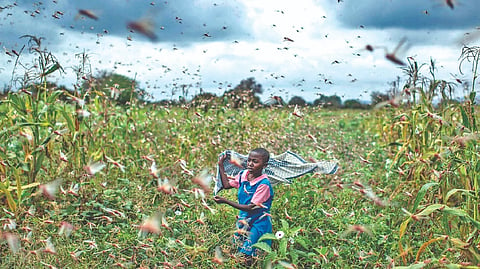

NEW YORK: Electrical charges are everywhere, both positive and negative ones. As opposite charges pull on each other, like charges push each other away. While these forces often go unnoticed on a human scale, they can have an outsize effect on small animals and plants.
Honeybees, for instance, collect a positive charge as their wings — which beat more than 200 times a second — rub against molecules in the air, and use it to attract negatively charged pollen; they can also detect and modify the electric fields of flowers. Spiders spin negatively charged webs that reach out to trap positively charged insects, and they use the electric fields of trees to float through the air. Positively charged hummingbirds pull negatively charged plant stamens toward their beaks. The ecosystem is buzzing with electricity, albeit on a tiny scale.
But it’s less tiny than previously thought. A study published Monday in the journal iScience found that when insects like honeybees and locusts gathered in swarms, the individual charges in each creature aggregated to form electric fields in the atmosphere as strong as those created by thunderstorms. While additional research will be needed to confirm their exact climatic effect, the trillions of tiny bodies that electrify the air could help to explain basic weather events, like the formation of clouds, and fill in a picture of the complex environment around us.
Víctor Ortega-Jiménez, a biomechanics researcher at the University of Maine who was not involved in the research, said that this study was the first to confirm the large-scale electrical effect of animals on the atmosphere and that “it opens a lot of possibilities.”
“Swarms of insects are everywhere — you can see it in mosquitoes, you can see it in bees, you can see it in locusts and birds,” he said. “Imagine all this potential.”
The study of how electrostatic forces affect living things in an ecosystem is known as electric ecology. Ellard Hunting, a biologist at the University of Bristol in England and author of the study, has helped develop this field of inquiry with a number of colleagues. Their research has often focused on the ways that insects — particularly honeybees in hives kept at the university — interact with their charged environments.
Scientists measure the strength of the electric field in the atmosphere by calculating the difference between the charge at Earth’s surface and in the air above the ground. This is known as the potential gradient, and it is important in predicting the weather and understanding the chemical composition of the air. Regular changes in the gradient even affect how animals navigate their surroundings.
In the past few years, the Bristol researchers found that insects picked up charge not just while flying but also by rubbing against each other and walking on frictional surfaces. They looked at how this charge affected the behavior of insects in part by watching the university’s honeybees fly around, then measuring the electric fields produced by plants they visited. While doing this, Hunting noticed that, when the insects swarmed, there was a “profound effect” on the atmosphere’s potential gradient.
Visit news.dtnext.in to explore our interactive epaper!
Download the DT Next app for more exciting features!
Click here for iOS
Click here for Android